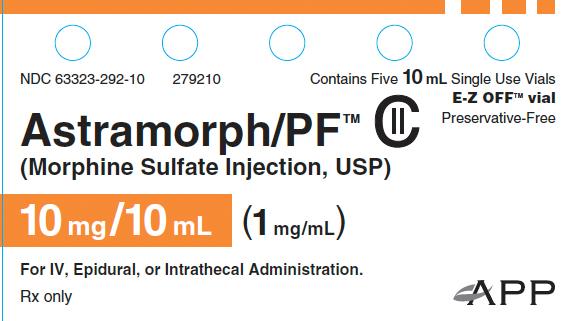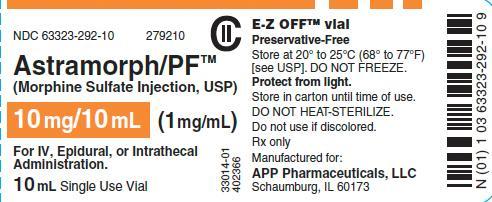Astramorph PF: Package Insert / Prescribing Info
Package insert / product label
Generic name: morphine sulfate
Dosage form: injection, solution
Drug class: Opioids (narcotic analgesics)
Medically reviewed by Drugs.com. Last updated on Mar 25, 2024.
On This Page

451103/Revised: June 2008
Astramorph/PF™ (Morphine Sulfate Injection, USP) Preservative-Free
Rx only
Astramorph PF Description
Morphine is the most important alkaloid of opium and is a phenanthrene derivative. It is available as the sulfate salt, having the following structural formula:
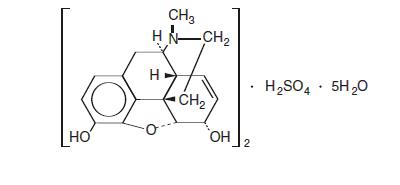
7,8-Didehydro-4,5-epoxy-17-methyl-(5α,6α)-morphinan-3,6-diol sulfate (2:1) (salt), pentahydrate
(C17H19NO3)2
•H2SO4 • 5H2O
Molecular Weight is 758.83
Preservative-free ASTRAMORPH/PF (Morphine Sulfate Injection, USP) is a sterile, nonpyrogenic, isobaric solution of morphine sulfate, free of antioxidants, preservatives or other potentially neurotoxic additives and is intended for intravenous, epidural or intrathecal administration as a narcotic analgesic. Each milliliter contains morphine sulfate 0.5 mg or 1 mg and sodium chloride 9 mg in Water for Injection. pH range is 2.5–6.5. Ampules and vials are sealed under nitrogen. Each ampule and vial is intended for SINGLE USE ONLY. Discard any unused portion. DO NOT HEAT-STERILIZE.
Astramorph PF - Clinical Pharmacology
Morphine produces a wide spectrum of pharmacologic effects including analgesia, dysphoria, euphoria, somnolence, respiratory depression, diminished gastrointestinal motility and physical dependence. Opiate analgesia involves at least three anatomical areas of the central nervous system: the periaqueductal-periventricular gray matter, the ventromedial medulla and the spinal cord. A systemically administered opiate may produce analgesia by acting at any, all or some combination of these distinct regions. Morphine interacts predominantly with the μ-receptor. The μ-binding sites of opioids are very discretely distributed in the human brain, with high densities of sites found in the posterior amygdala, hypothalamus, thalamus, nucleus caudatus, putamen and certain cortical areas. They are also found on the terminal axons of primary afferents within laminae I and II (substantia gelatinosa) of the spinal cord and in the spinal nucleus of the trigeminal nerve.
Morphine has an apparent volume of distribution ranging from 1.0 to 4.7 L/kg after intravenous dosage. Protein binding is low, about 36%, and muscle tissue binding is reported as 54%. A blood-brain barrier exists, and when morphine is introduced outside of the CNS (e.g., intravenously), plasma concentrations of morphine remain higher than the corresponding CSF morphine levels. Conversely, when morphine is injected into the intrathecal space, it diffuses out into the systemic circulation slowly, accounting for the long duration of action of morphine administered by this route.
Morphine has a total plasma clearance which ranges from 0.9 to 1.2 L/kg/h (liters/kilogram/hour) in postoperative patients, but shows considerable interindividual variation. The major pathway of clearance is hepatic glucuronidation to morphine-3-glucuronide, which is pharmacologically inactive. The major excretion path of the conjugate is through the kidneys, with about 10% in the feces. Morphine is also eliminated by the kidneys, 2 to 12% being excreted unchanged in the urine. Terminal half-life is commonly reported to vary from 1.5 to 4.5 hours, although the longer half-lives were obtained when morphine levels were monitored over protracted periods with very sensitive radioimmunoassay methods. The accepted elimination half-life in normal subject is 1.5 to 2 hours.
"Selective" blockade of pain sensation is possible by neuraxial application of morphine. In addition, duration of analgesia may be much longer by this route compared to systemic administration. However, CNS effects, associated with systemic administration, are still seen. These include respiratory depression, sedation, nausea and vomiting, pruritus and urinary retention. In particular, both early and late respiratory depression (up to 24 hours post dosing) have been reported following neuraxial administration. Circulation of the spinal fluid may also result in high concentrations of morphine reaching the brain stem directly.
The incidence of unwanted CNS effects, including delayed respiratory depression, associated with neuraxial application of morphine, is related to the circulatory dynamics of the epidural venous plexus and the spinal fluid. The lipid solubility and degree of ionization of morphine plays an important part in both the onset and duration of analgesia and the CNS effects. Morphine has a pKa 7.9, with an octanol/water partition coefficient of 1.42 at pH 7.4. At this pH, the tertiary amino group in each of the opioids is mostly ionized, making the molecule water soluble. Morphine, with additional hydroxyl groups on the molecule, is significantly more water soluble than any other opioid in clinical use.
Morphine, injected into the epidural space, is rapidly absorbed into the general circulation. Absorption is so rapid that the plasma concentration-time profiles closely resemble those obtained after intravenous or intramuscular administration. Peak plasma concentrations averaging 33 to 40 ng/mL (range 5 to 62 ng/mL) are achieved within 10 to 15 minutes after administration of 3 mg of morphine. Plasma concentrations decline in a multiexponential fashion. The terminal half-life is reported to range from 39 to 249 minutes (mean of 90±34.3 min) and, though somewhat shorter, is similar in magnitude as values reported after intravenous and intramuscular administration (1.5 to 4.5 h). CSF concentrations of morphine, after epidural doses of 2 to 6 mg in postoperative patients, have been reported to be 50 to 250 times higher than corresponding plasma concentrations. The CSF levels of morphine exceed those in plasma after only 15 minutes and are detectable for as long as 20 hours after the injection of 2 mg of epidural morphine. Approximately 4% of the dose injected epidurally reaches the CSF. This corresponds to the relative minimum effective epidural and intrathecal doses of 5 mg and 0.25 mg, respectively. The disposition of morphine in the CSF follows a biphasic pattern, with an early half-life of 1.5 h and a late phase half-life of about 6 h. Morphine crosses the dura slowly, with an absorption half-life across the dura averaging 22 minutes. Maximum CSF concentrations are seen 60 to 90 minutes after injection. Minimum effective CSF concentrations for postoperative analgesia average 150 ng/mL (range <1 to 380 ng/mL).
The intrathecal route of administration circumvents meningeal diffusion barriers and, therefore, lower doses of morphine produce comparable analgesia to that induced by the epidural route. After intrathecal bolus injection of morphine, there is a rapid initial distribution phase lasting 15 to 30 minutes and a half-life in the CSF of 42 to 136 min (mean 90 ± 16 min). Derived from limited data, it appears that the disposition of morphine in the CSF, from 15 minutes postintrathecal administration to the end of a six-hour observation period, represents a combination of the distribution and elimination phases. Morphine concentrations in the CSF averaged 332 ± 137 ng/mL at 6 hours, following a bolus dose of 0.3 mg of morphine. The apparent volume of distribution of morphine in the intrathecal space is about 22 ± 8 mL.
Time-to-peak plasma concentrations, however, are similar (5 to 10 min) after either epidural or intrathecal bolus administration of morphine. Maximum plasma morphine concentrations after 0.3 mg intrathecal morphine have been reported from <1 to 7.8 ng/mL. The minimum analgesic morphine plasma concentration during Patient-Controlled Analgesia (PCA) has been reported as 20 to 40 ng/mL, suggesting that any analgesic contribution from systemic redistribution would be minimal after the first 30 to 60 minutes with epidural administration and virtually absent with intrathecal administration of morphine.
Indications and Usage for Astramorph PF
Astramorph/PF is a systemic narcotic analgesic for administration by the intravenous, epidural or intrathecal routes. It is used for the management of pain not responsive to non-narcotic analgesics. Astramorph/PF, administered epidurally or intrathecally, provides pain relief for extended periods without attendant loss of motor, sensory or sympathetic function.
Contraindications
Astramorph/PF is contraindicated in those medical conditions which would preclude the administration of opioids by the intravenous route—allergy to morphine or other opiates, acute bronchial asthma, upper airway obstruction.
Astramorph/PF, like all opioid analgesics, may cause severe hypotension in an individual whose ability to maintain blood pressure has already been compromised by a depleted blood volume or a concurrent administration of drugs, such as phenothiazines or general anesthetics (see also, PRECAUTIONS: Use with Other Central Nervous System Depressants).
Warnings
Morphine sulfate may be habit forming (see DRUG ABUSE AND DEPENDENCE). Overdoses may cause respiratory depression, coma and death.
Astramorph/PF administration should be limited to use by those familiar with the management of respiratory depression. Rapid intravenous administration may result in chest wall rigidity.
Prior to any epidural or intrathecal drug administration, the physician should be familiar with patient conditions (such as infection at the injection site, bleeding diathesis, anticoagulant therapy, etc.) which call for special evaluation of the benefit versus risk potential.
In the case of epidural or intrathecal administration, Astramorph/PF should be administered by or under the direction of a physician experienced in the techniques and familiar with the patient management problems associated with epidural or intrathecal drug administration. Because epidural administration has been associated with less potential for immediate or late adverse effects than intrathecal administration, the epidural route should be used whenever possible. SEVERE RESPIRATORY DEPRESSION UP TO 24 HOURS FOLLOWING EPIDURAL OR INTRATHECAL ADMINISTRATION HAS BEEN REPORTED.
|
BECAUSE OF THE RISK OF SEVERE ADVERSE EFFECTS WHEN THE EPIDURAL OR INTRATHECAL ROUTE OF ADMINISTRATION IS EMPLOYED, PATIENTS MUST BE OBSERVED IN A FULLY EQUIPPED AND STAFFED ENVIRONMENT FOR AT LEAST 24 HOURS AFTER THE INITIAL DOSE. |
THE FACILITY MUST BE EQUIPPED TO RESUSCITATE PATIENTS WITH SEVERE OPIATE OVERDOSAGE, AND THE PERSONNEL MUST BE FAMILIAR WITH THE USE AND LIMITATIONS OF SPECIFIC NARCOTIC ANTAGONISTS (NALOXONE, NALTREXONE) IN SUCH CASES.
Tolerance and Myoclonic Activity:
PATIENTS SOMETIMES MANIFEST UNUSUAL ACCELERATION OF NEURAXIAL MORPHINE REQUIREMENTS, WHICH MAY CAUSE CONCERN REGARDING SYSTEMIC ABSORPTION AND THE HAZARDS OF LARGE DOSES; THESE PATIENTS MAY BENEFIT FROM HOSPITALIZATION AND DETOXIFICATION. TWO CASES OF MYOCLONIC-LIKE SPASM OF THE LOWER EXTREMITIES HAVE BEEN REPORTED IN PATIENTS RECEIVING MORE THAN 20 MG/DAY OF INTRATHECAL MORPHINE. AFTER DETOXIFICATION, IT MIGHT BE POSSIBLE TO RESUME TREATMENT AT LOWER DOSES, AND SOME PATIENTS HAVE BEEN SUCCESSFULLY CHANGED FROM CONTINUOUS EPIDURAL MORPHINE TO CONTINUOUS INTRATHECAL MORPHINE. REPEAT DETOXIFICATION MAY BE INDICATED AT A LATER DATE. THE UPPER DAILY DOSAGE LIMIT FOR EACH PATIENT DURING CONTINUING TREATMENT MUST BE INDIVIDUALIZED.
Precautions
General:
Control of pain by neuraxial opiate delivery is always accompanied by considerable risk to the patients and requires a high level of skill to be successfully accomplished. The task of treating these patients must be undertaken by experienced clinical teams, well-versed in patient selection, evolving technology and emerging standards of care. For safety reasons, it is recommended that administration of Astramorph/PF by the epidural or intrathecal routes be limited to the lumbar area. Intrathecal use has been associated with a higher incidence of respiratory depression than epidural use.
Seizures may result from high doses. Patients with known seizure disorders should be carefully observed for evidence of morphine-induced seizure activity.
Use in Patients with Increased Intracranial Pressure or Head Injury:
Astramorph/PF should be used with extreme caution in patients with head injury or increased intracranial pressure. Pupillary changes (miosis) from morphine may obscure the existence, extent and course of intracranial pathology. High doses of neuraxial morphine may produce myoclonic events (see WARNINGSand ADVERSE REACTIONS). Clinicians should maintain a high index of suspicion for adverse drug reactions when evaluating altered mental status or movement abnormalities in patients receiving this modality of treatment.
Use in Chronic Pulmonary Disease:
Care is urged in using this drug in patients who have a decreased respiratory reserve (e.g., emphysema, severe obesity, kyphoscoliosis or paralysis of the phrenic nerve). Astramorph/PF should not be given in cases of chronic asthma, upper airway obstruction or in any other chronic pulmonary disorder without due consideration of the known risk of acute respiratory failure following morphine administration in such patients.
Use in Hepatic or Renal Disease:
The elimination half-life of morphine may be prolonged in patients with reduced metabolic rates and with hepatic and/or renal dysfunction. Hence, care should be exercised in administering Astramorph/PF epidurally to patients with these conditions, since high blood morphine levels, due to reduced clearance, may take several days to develop.
Use in Biliary Surgery or Disorders of the Biliary Tract:
As significant morphine is released into the systemic circulation from neuraxial administration, the ensuing smooth muscle hypertonicity may result in biliary colic.
Use with Disorders of the Urinary System:
Initiation of neuraxial opiate analgesia is frequently associated with disturbances of micturition, especially in males with prostatic enlargement. Early recognition of difficulty in urination and prompt intervention in cases of urinary retention is indicated.
Use in Ambulatory Patients:
Patients with reduced circulating blood volume, impaired myocardial function or on sympatholytic drugs should be monitored for the possible occurrence of orthostatic hypotension, a frequent complication in single-dose neuraxial morphine analgesia.
Use with Other Central Nervous System Depressants:
The depressant effects of morphine are potentiated by the presence of other CNS depressants such as alcohol, sedatives, antihistaminics or psychotropic drugs. Use of neuroleptics in conjunction with neuraxial morphine may increase the risk of respiratory depression.
Carcinogenesis, Mutagenesis, Impairment of Fertility:
Morphine is without known carcinogenic or mutagenic effects and is not known to impair fertility at non-narcotic doses in animals, but studies of the carcinogenic and mutagenic potential or the effect on fertility of Astramorph/PF have not been conducted.
Pregnancy:
TERATOGENIC EFFECTS–PREGNANCY CATEGORY C:
Morphine sulfate is not teratogenic in rats at 35 mg/kg/day (thirty-five times the usual human dose) but does result in increased pup mortality and growth retardation at doses that narcotize the animal (>10 mg/kg/day, ten times the usual human dose). Astramorph/PF should only be given to pregnant women when no other method of controlling pain is available and means are at hand to manage the delivery and perinatal care of the opiate-dependent infant.
Labor and Delivery:
Intravenous morphine readily passes into the fetal circulation and may result in respiratory depression in the neonate. Naloxone and resuscitative equipment should be available for reversal of narcotic-induced respiratory depression in the neonate. In addition, intravenous morphine may reduce the strength, duration and frequency of uterine contraction resulting in prolonged labor.
Epidurally and intrathecally administered morphine readily passes into the fetal circulation and may result in respiratory depression of the neonate. Controlled clinical studies have shown that epidural administration has little or no effect on the relief of labor pain.
Nursing Mothers:
Morphine is excreted in maternal milk. Effects on the nursing infant are not known.
Pediatric Use:
Adequate studies, to establish the safety and effectiveness of spinal morphine in pediatric patients, have not been performed, and usage in this population is not recommended.
Geriatric Use:
The pharmacodynamic effects of neuraxial morphine in the elderly are more variable than in the younger population. Patients will vary widely in the effective initial dose, rate of development of tolerance and the frequency and magnitude of associated adverse effects as the dose is increased. Initial doses should be based on careful clinical observation following "test doses", after making due allowances for the effects of the patient's age and infirmity on his/her ability to clear the drug, particularly in patients receiving epidural morphine.
Elderly patients may be more susceptible to respiratory depression and/or respiratory arrest following administration of morphine.
Adverse Reactions/Side Effects
The most serious adverse experience encountered during administration of Astramorph/PF is respiratory depression and/or respiratory arrest. This depression and/or respiratory arrest may be severe and could require intervention (see WARNINGS and OVERDOSAGE). Because of delay in maximum CNS effect with intravenously administered drug (30 min), rapid administration may result in overdosing. Single-dose neuraxial administration may result in acute or delayed respiratory depression for periods at least as long as 24 hours.
Tolerance and Myoclonus:
See WARNINGSfor discussion of these and related hazards.
While low doses of intravenously administered morphine have little effect on cardiovascular stability, high doses are excitatory, resulting from sympathetic hyperactivity and increase in circulating catecholamines. Excitation of the central nervous system, resulting in convulsions, may accompany high doses of morphine given intravenously. Dysphoric reactions may occur after any size dose and toxic psychoses have been reported.
Pruritus:
Single-dose epidural or intrathecal administration is accompanied by a high incidence of pruritus that is dose-related but not confined to the site of administration. Pruritus, following continuous infusion of epidural or intrathecal morphine, is occasionally reported in the literature; these reactions are poorly understood as to their cause.
Urinary retention:
Urinary retention, which may persist 10 to 20 hours following single epidural or intrathecal administration, is a frequent side effect and must be anticipated primarily in male patients, with a somewhat lower incidence in females. Also frequently reported in the literature is the occurrence of urinary retention during the first several days of hospitalization for the initiation of continuous intrathecal or epidural morphine therapy. Patients who develop urinary retention have responded to cholinomimetic treatment and/or judicious use of catheters (see PRECAUTIONS).
Constipation:
Constipation is frequently encountered during continuous infusion of morphine; this can usually be managed by conventional therapy.
Headache:
Lumbar puncture-type headache is encountered in a significant minority of cases for several days following intrathecal catheter implantation; this, generally, responds to bed rest and/or other conventional therapy.
Other:
Other adverse experiences reported following morphine therapy include—Dizziness, euphoria, anxiety, hypotension, confusion, reduced male potency, decreased libido in men and women, and menstrual irregularities including amenorrhea, depression of cough reflex, interference with thermal regulation and oliguria. Evidence of histamine release such as urticaria, wheals and/or local tissue irritation may occur. Nausea and vomiting are frequently seen in patients following morphine administration.
Pruritus, nausea/vomiting and urinary retention, if associated with continuous infusion therapy, may respond to intravenous administration of a low dose of naloxone (0.2 mg). The risks of using narcotic antagonists in patients chronically receiving narcotic therapy should be considered.
In general, side effects are amenable to reversal by narcotic antagonists.
| NALOXONE INJECTION AND RESUSCITATIVE EQUIPMENT SHOULD BE IMMEDIATELY AVAILABLE FOR ADMINISTRATION IN CASE OF LIFE-THREATENING OR INTOLERABLE SIDE EFFECTS AND WHENEVER ASTRAMORPH/PF THERAPY IS BEING INITIATED. |
Drug Abuse and Dependence
Controlled Substance:
Morphine sulfate is a Schedule II narcotic under the United States Controlled Substance Act (21 U.S.C. 801–886).
Morphine is the most commonly cited prototype for narcotic substances that possess an addiction-forming or addiction-sustaining liability. A patient may be at risk for developing a dependence to morphine if used improperly or for overly long periods of time. As with all potent opioids which are μ-agonists, tolerance as well as psychological and physical dependence to morphine may develop irrespective of the route of administration (intravenous, intramuscular, intrathecal, epidural or oral). Individuals with a prior history of opioid or other substance abuse or dependence, being more apt to respond to the euphorogenic and reinforcing properties of morphine, would be considered to be at greater risk.
Care must be taken to avert withdrawal in patients who have been maintained on parenteral/oral narcotics when epidural or intrathecal administration is considered. Withdrawal symptoms may occur when morphine is discontinued abruptly or upon administration of a narcotic antagonist.
Overdosage
PARENTERAL ADMINISTRATION OF NARCOTICS IN PATIENTS RECEIVING EPIDURAL OR INTRATHECAL MORPHINE MAY RESULT IN OVERDOSAGE.
Overdosage of morphine is characterized by respiratory depression, with or without concomitant CNS depression. In severe overdosage, apnea, circulatory collapse, cardiac arrest and death may occur. Since respiratory arrest may result either through direct depression of the respiratory center or as the result of hypoxia, primary attention should be given to the establishment of adequate respiratory exchange through provision of a patent airway and institution of assisted, or controlled, ventilation. The narcotic antagonist, naloxone, is a specific antidote. An initial dose of 0.4 to 2 mg of naloxone should be administered intravenously, simultaneously with respiratory resuscitation. If the desired degree of counteraction and improvement in respiratory function is not obtained, naloxone may be repeated at 2- to 3-minute intervals. If no response is observed after 10 mg of naloxone has been administered, the diagnosis of narcotic-induced, or partial narcotic-induced, toxicity should be questioned. Intramuscular or subcutaneous administration may be used if the intravenous route is not available.
As the duration of effect of naloxone is considerably shorter than that of epidural or intrathecal morphine, repeated administration may be necessary. Patients should be closely observed for evidence of renarcotization.
Astramorph PF Dosage and Administration
Astramorph/PF is intended for intravenous, epidural or intrathecal administration.
Intravenous Administration:
Epidural Administration:
ASTRAMORPH/PF SHOULD BE ADMINISTERED EPIDURALLY BY OR UNDER THE DIRECTION OF A PHYSICIAN EXPERIENCED IN THE TECHNIQUE OF EPIDURAL ADMINISTRATION AND WHO IS THOROUGHLY FAMILIAR WITH THE LABELING. IT SHOULD BE ADMINISTERED ONLY IN SETTINGS WHERE ADEQUATE PATIENT MONITORING IS POSSIBLE. RESUSCITATIVE EQUIPMENT AND A SPECIFIC ANTAGONIST (NALOXONE INJECTION) SHOULD BE IMMEDIATELY AVAILABLE FOR THE MANAGEMENT OF RESPIRATORY DEPRESSION AS WELL AS COMPLICATIONS WHICH MIGHT RESULT FROM INADVERTENT INTRATHECAL OR INTRAVASCULAR INJECTION. (NOTE: INTRATHECAL DOSAGE IS USUALLY 1/10 THAT OF EPIDURAL DOSAGE.) PATIENT MONITORING SHOULD BE CONTINUED FOR AT LEAST 24 HOURS AFTER EACH DOSE, SINCE DELAYED RESPIRATORY DEPRESSION MAY OCCUR.
Proper placement of a needle or catheter in the epidural space should be verified before Astramorph/PF is injected. Acceptable techniques for verifying proper placement include: a) aspiration to check for absence of blood or cerebrospinal fluid, or b) administration of 5 mL (3 mL in obstetric patients) of 1.5% PRESERVATIVE-FREE Lidocaine and Epinephrine (1:200,000) Injection and then observe the patient for lack of tachycardia (this indicates that vascular injection has not been made) and lack of sudden onset of segmental anesthesia (this indicates that intrathecal injection has not been made).
EPIDURAL ADULT DOSAGE:
Initial injection of 5 mg in the lumbar region may provide satisfactory pain relief for up to 24 hours. If adequate pain relief is not achieved within one hour, careful administration of incremental doses of 1 to 2 mg at intervals sufficient to assess effectiveness may be given. No more than 10 mg/24 hr should be administered.
Thoracic administration has been shown to dramatically increase the incidence of early and late respiratory depression even at doses of 1 to 2 mg.
For continuous infusion an initial dose of 2 to 4 mg/24 hours is recommended. Further doses of 1 to 2 mg may be given if pain relief is not achieved initially.
Intrathecal Administration
| NOTE: INTRATHECAL DOSAGE IS USUALLY 1/10 THAT OF EPIDURAL DOSAGE. |
ASTRAMORPH/PF SHOULD BE ADMINISTERED INTRATHECALLY BY OR UNDER THE DIRECTION OF A PHYSICIAN EXPERIENCED IN THE TECHNIQUE OF INTRATHECAL ADMINISTRATION AND WHO IS THOROUGHLY FAMILIAR WITH THE LABELING. IT SHOULD BE ADMINISTERED ONLY IN SETTINGS WHERE ADEQUATE PATIENT MONITORING IS POSSIBLE. RESUSCITATIVE EQUIPMENT AND A SPECIFIC ANTAGONIST (NALOXONE INJECTION) SHOULD BE IMMEDIATELY AVAILABLE FOR THE MANAGEMENT OF RESPIRATORY DEPRESSION AS WELL AS COMPLICATIONS WHICH MIGHT RESULT FROM INADVERTENT INTRAVASCULAR INJECTION. PATIENT MONITORING SHOULD BE CONTINUED FOR AT LEAST 24 HOURS AFTER EACH DOSE, SINCE DELAYED RESPIRATORY DEPRESSION MAY OCCUR. RESPIRATORY DEPRESSION (BOTH EARLY AND LATE ONSET) HAS OCCURRED MORE FREQUENTLY FOLLOWING INTRATHECAL ADMINISTRATION THAN EPIDURAL ADMINISTRATION.
INTRATHECAL ADULT DOSAGE:
A single injection of 0.2 to 1 mg may provide satisfactory pain relief for up to 24 hours. (CAUTION: THIS IS ONLY 0.4 TO 2 ML OF THE 5 MG/10 ML AMPULE/VIAL OR 0.2 TO 1 ML OF THE 10 MG/10 ML AMPULE/VIAL OF ASTRAMORPH/PF). DO NOT INJECT INTRATHECALLY MORE THAN 2 ML OF THE 5 MG/10 ML AMPULE/VIAL OR 1 ML OF THE 10 MG/10 ML AMPULE/VIAL. USE IN THE LUMBAR AREA ONLY IS RECOMMENDED. Repeated intrathecal injections of Astramorph/PF are not recommended. A constant intravenous infusion of naloxone, 0.6 mg/hr, for 24 hours after intrathecal injection may be used to reduce the incidence of potential side effects.
REPEAT DOSAGE:
If pain recurs, alternative routes of administration should be considered, since experience with repeated doses of morphine by the intrathecal route is limited.
INTRATHECAL PEDIATRIC USE:
No information on use in pediatric patients is available (see PRECAUTIONS).
SAFETY AND HANDLING INSTRUCTIONS
| Astramorph/PF is supplied in sealed ampules and
vials. Accidental dermal exposure should be treated by the removal of any contaminated clothing and rinsing the affected area with water. Each
ampule/vial of Astramorph/PF contains a potent
narcotic which has
Parenteral
drug products should be inspected for particulate
matter and |
How is Astramorph PF supplied
Preservative-Free ASTRAMORPH/PFTM (Morphine Sulfate Injection, USP) is available in ampules and single dose vials for intravenous, epidural, or intrathecal administration:
|
Product No. |
NDC No. | Strength | Vial Size |
| 279180 | 63323-291-80 | 0.5 mg/mL | 2 mL (1 mg) ampule packaged in tens. |
| 279197 | 63323-291-97 | 0.5 mg/mL | 10 mL (5 mg) ampule packaged in fives. |
| 279110 | 63323-291-10 | 0.5 mg/mL | 10 mL (5 mg) single dose vial packaged in fives. E-Z off vial closures. |
| 279280 | 63323-292-80 | 1 mg/mL | 2 mL (2 mg) ampule packaged in tens. |
| 279297 | 63323-292-97 | 1 mg/mL | 10 mL (10 mg) ampule packaged in fives. |
| 279210 | 63323-292-10 | 1 mg/mL | 10 mL (10 mg) single dose vial packaged in fives. E-Z off vial closures. |
Storage
PROTECT FROM LIGHT. Store in carton at 20° to 25°C (68° to 77°F) [see USP Controlled Room Temperature] until ready to use. DO NOT FREEZE.
Astramorph/PF contains no preservative or antioxidant. DISCARD ANY UNUSED PORTION. DO NOT HEAT-STERILIZE.
All trademarks are the property of APP Pharmaceuticals, LLC.
Manufactured for:

451103/Revised: June 2008
PACKAGE LABEL- PRINCIPAL DISPLAY- Astramorph 2 mL Ampule Carton Panel
NDC 63323-291-80
279180
10 Ampules, 2 mL
Astramorph/PF™
(Morphine Sulfate Injection,
USP)
1 mg/2 mL (0.5 mg/mL)
For IV, Epidural, or Intrathecal Administration.
Preservative-Free
Rx only
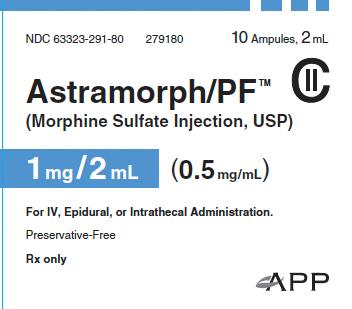
PACKAGE LABEL- PRINCIPAL DISPLAY- Astramorph 2 mL Ampule Label
NDC 63323-291-80
2 mL
Astramorph/PF™
(Morphine Sulfate Injection,
USP)
1 mg/2 mL (0.5 mg/mL)
Preservative-Free
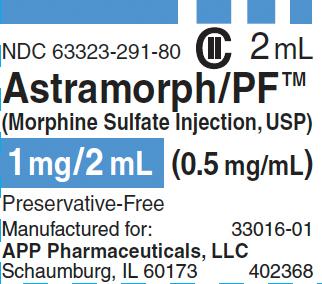
PACKAGE LABEL- PRINCIPAL DISPLAY- Astramorph 10 mL Ampule Carton Panel
NDC 63323-291-97
279197
Astramorph/PF™
(Morphine Sulfate Injection,
USP)
5 mg/10 mL (0.5 mg/mL)
For IV, Epidural, or Intrathecal Administration.
Preservative-Free
Rx only
Contains Five 10 mL Ampules
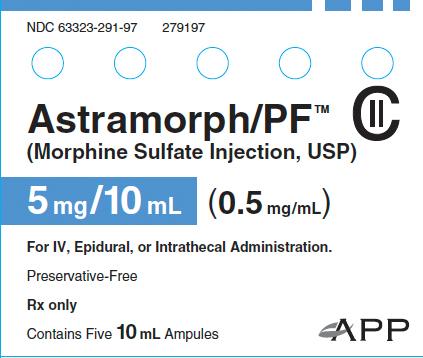
PACKAGE LABEL- PRINCIPAL DISPLAY- Astramorph 10 mL Ampule Label
NDC 63323-291-97
10 mL
Preservative-Free
Astramorph/PF™
(Morphine Sulfate Injection,
USP)
5 mg/10 mL (0.5 mg/mL)
For IV, Epidural, or Intrathecal Administration.
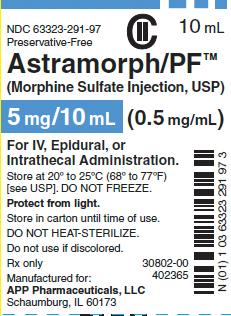
| ASTRAMORPH
PF
morphine sulfate injection, solution |
||||||||||||||||||||||||||||||
|
||||||||||||||||||||||||||||||
|
||||||||||||||||||||||||||||||
|
||||||||||||||||||||||||||||||
|
||||||||||||||||||||||||||||||
|
||||||||||||||||||||||||||||||
| ASTRAMORPH
PF
morphine sulfate injection, solution |
||||||||||||||||||||
|
||||||||||||||||||||
|
||||||||||||||||||||
|
||||||||||||||||||||
|
||||||||||||||||||||
|
||||||||||||||||||||
| Labeler - Fresenius Kabi USA, LLC (608775388) |
| Establishment | |||
| Name | Address | ID/FEI | Business Operations |
|---|---|---|---|
| AstraZeneca LP | 176650158 | ANALYSIS(63323-291, 63323-292) , MANUFACTURE(63323-291, 63323-292) | |
Frequently asked questions
- Which drugs cause opioid-induced constipation?
- Which painkiller should you use?
- How does fentanyl compare to heroin or other opiates?
More about Astramorph PF (morphine)
- Check interactions
- Compare alternatives
- Latest FDA alerts (12)
- Side effects
- Dosage information
- During pregnancy
- Drug class: Opioids (narcotic analgesics)
- Breastfeeding
Patient resources
Professional resources
Other brands
MS Contin, Kadian, Duramorph, MorphaBond ER, ... +3 more

